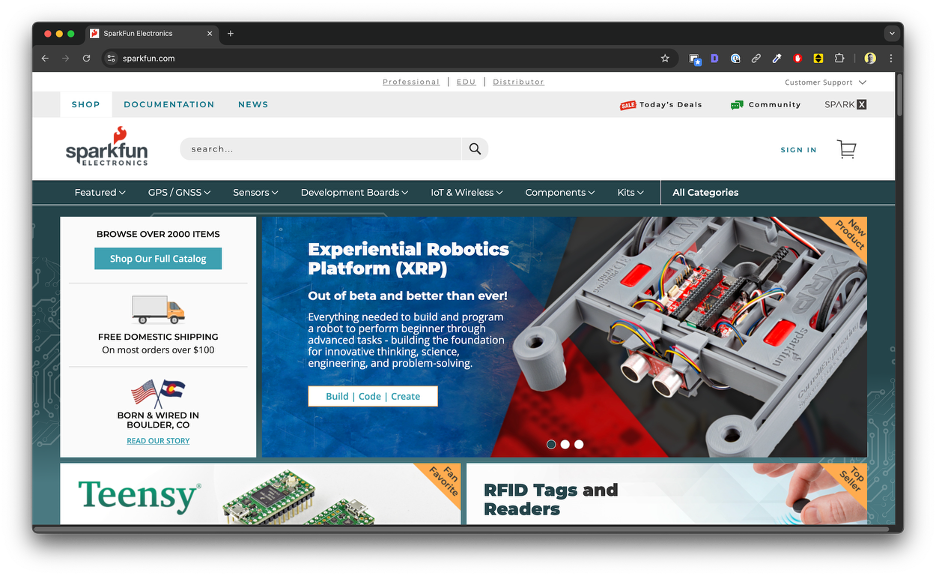
What is Adobe Commerce (Formerly Magento)? Comprehensive Guide for 2025


Adobe Commerce is a flexible, cloud-based eCommerce platform built for mid- to large-scale enterprises that need to deliver personalized, scalable, and omnichannel shopping experiences.
Originally known as Magento Commerce, Adobe Commerce combines open-source extensibility with powerful native features. These include AI-driven personalization, advanced customer segmentation, multi-site management, and B2B capabilities.
It integrates seamlessly with the Adobe Experience Cloud, allowing marketing, analytics, and commerce teams to unify customer data and orchestrate real-time, cross-channel journeys.
Adobe Commerce is designed to support both B2B and B2C models and is especially suited for organizations with complex catalogs, global storefronts, or custom operational workflows.
In this article, we’ll explore:
How Adobe Commerce empowers businesses with flexible and scalable eCommerce capabilities
How it compares to other leading platforms
What you need to know before implementing it in your organization
Key Features of Adobe Commerce
Visual Merchandising and Content Management Tools
Marketers can easily manage eCommerce store content using drag-and-drop tools, page builders, and in-context editing without developer involvement. This empowers teams to launch new campaigns, seasonal updates, or product showcases quickly and consistently across channels.
AI-Driven Personalization and Product Recommendations
Adobe Commerce uses Adobe Sensei, its AI engine, to deliver real-time product recommendations, personalized search results, and intelligent merchandising. These features help businesses increase average order value and conversion rates by showing customers the most relevant products at the right time.
Customer Segmentation and Targeting
Adobe Commerce enables dynamic customer segmentation based on behavior, demographics, purchase history, and more. Businesses can tailor promotions, content, and product visibility for specific audiences to drive engagement and retention.
Multi-Site, Multi-Brand, and Multi-Language Support
With a single Adobe Commerce instance, businesses can operate multiple storefronts for different brands, regions, or languages—each with unique catalogs, pricing, and experiences. This reduces operational overhead while enabling global expansion and localization.
Integrated B2B and B2C Commerce Capabilities
Adobe Commerce supports complex B2B workflows like custom pricing, quotes, requisition lists, and corporate account hierarchies all within the same platform used for B2C selling. This allows companies to manage both customer types efficiently under one roof, without siloed systems.
Robust API and Headless Commerce Support
The platform provides comprehensive REST and GraphQL APIs, allowing businesses to power custom frontends, mobile apps, or IoT devices using headless architecture. This flexibility future-proofs the tech stack and supports rapid experimentation with digital experiences.
Powerful Promotion and Discount Engine
Adobe Commerce includes a flexible rule-based engine for creating tiered discounts, coupons, free shipping thresholds, and more. These tools help marketers quickly launch targeted promotions that drive urgency, increase basket size, and support conversion goals.
Who is Adobe Commerce For?
Adobe Commerce is ideal for businesses with complex eCommerce needs that demand flexibility, scalability, and deep integration capabilities.
Mid-Market and Enterprise Retailers: For retailers managing extensive product catalogs, high transaction volumes, or intricate promotional strategies, Adobe Commerce offers the scalability and customization required to support omnichannel growth and advanced merchandising.
Manufacturers and Wholesalers with B2B Needs: Businesses seeking to digitize their sales processes benefit from Adobe Commerce's native B2B features, including custom pricing, quote workflows, buyer roles, and account hierarchies, eliminating the need for third-party add-ons.
Brands with Multiple Storefronts or Regions: Companies operating across various brands, regions, or languages can manage multiple storefronts from a single backend, streamlining operations while allowing for localized customization.
Companies Using Adobe Experience Cloud Tools: Organizations already leveraging Adobe tools like Adobe Analytics, Adobe Target, Adobe Campaign, or Adobe Experience Manager will find seamless integration with Adobe Commerce, enabling unified customer experiences across all digital touchpoints.
Integration with the Adobe Experience Cloud
One of Adobe Commerce’s greatest advantages over other eCommerce platforms is its deep integration with the Adobe Experience Cloud—a unified suite of tools for marketing, analytics, content management, and customer journey orchestration.
While many platforms require extensive third-party tools to unify customer data or personalize experiences across channels, Adobe Commerce is natively built to plug into Adobe’s enterprise ecosystem.
Journey Orchestration with Adobe Journey Optimizer
Adobe Journey Optimizer allows marketing teams to create and automate personalized journeys across email, web, push notifications, and more.
By pulling in data from Adobe Commerce (e.g., cart activity, order history), teams can trigger contextual messages and offers (like cart recovery emails or loyalty incentives) at precisely the right moment.
Personalization and A/B Testing via Adobe Target
With Adobe Target, businesses can run A/B and multivariate tests on their Adobe Commerce storefronts and deliver AI-powered personalization at scale.
Teams can test everything from homepage layouts to product detail pages and use behavioral data to serve tailored content that improves engagement and conversion.
Shared Customer Data Across Analytics, Campaign, and Commerce
Adobe Commerce shares a common data layer with Adobe Analytics and Adobe Campaign, meaning every click, view, and purchase is immediately accessible for analysis and activation.
This unified data model allows marketing teams to create cross-channel segments in Adobe Analytics, push campaigns in Adobe Campaign, and deliver on-site personalization in Commerce—all using the same customer intelligence.
Example: Specialty Sporting Goods Brand
Here's an example of how all this might play out in a real-world scenario:
Imagine a specialty sporting goods retailer that wants to deliver a truly personalized shopping experience. Using the Adobe Experience Cloud integration, their customer journey might look like this:
A customer browses hiking boots on the retailer's Adobe Commerce site but doesn't purchase. Adobe Analytics captures this browsing behavior and shares it with Adobe Real-Time CDP, which updates the customer's unified profile. The next day, Adobe Journey Optimizer automatically triggers a personalized email with those exact boots and related products.
When the customer returns through this email, Adobe Target recognizes them and dynamically modifies the homepage to showcase hiking gear based on their previous browsing patterns.
As they view product pages, Adobe Commerce's AI-powered recommendation engine suggests complementary items like appropriate socks and waterproofing spray.
After purchasing, the customer data flows seamlessly into Adobe Campaign for post-purchase nurturing with hiking trail recommendations and maintenance tips for their new boots—all personalized to their location and preferences captured across touchpoints.
This continuous, data-driven loop between commerce and marketing systems would typically require complex custom integrations with other platforms.
B2B vs. B2C Capabilities
Adobe Commerce is uniquely equipped to handle both B2B and B2C eCommerce within a single platform.
Unlike many competitors that require separate solutions or complex workarounds, Adobe Commerce allows businesses to manage wholesale and retail operations side by side—each with tailored experiences, workflows, and pricing strategies.
Native B2B Features (Quotes, Requisition Lists, Corporate Accounts)
Adobe Commerce offers built-in B2B capabilities designed to streamline complex purchasing workflows and enhance the buying experience for business clients.
Request for Quote (RFQ) Workflows: Buyers can initiate quotes directly from their cart, allowing sales reps to negotiate and respond with custom pricing and terms.
Requisition Lists: Users can create and save multiple lists of frequently purchased items for quick, repeat ordering.
Corporate Account Hierarchies: Businesses can establish parent-child account structures with role-based permissions and approval workflows.
Company Credit Management: Merchants can offer credit lines to B2B customers, with configurable credit limits and payment terms tracked within the platform.
Quick Order by SKU: Frequent buyers can expedite purchases by entering SKUs or uploading CSV files to add multiple products to their cart swiftly.
Custom Catalogs and Pricing: Assign unique product visibility and pricing to different business accounts, ensuring each buyer sees relevant offerings at their negotiated rates.
Purchase Order Support: B2B buyers can place orders using purchase order numbers, with built-in PO tracking for backend teams.
Native B2C Features (Personalization, Promotions, Customer Experience)
Adobe Commerce empowers retailers to craft engaging, personalized shopping experiences that drive conversions and foster customer loyalty.
AI-Powered Product Recommendations: Utilizing Adobe Sensei, the platform offers personalized product suggestions based on user behavior, enhancing cross-sell and upsell opportunities.
Advanced Promotions and Discounts: Merchants can configure rule-based promotions, coupons, and limited-time offers, enabling targeted campaigns without developer intervention.
Customer Segmentation and Targeted Content: Dynamic segments based on attributes like location or purchase history allow for personalized content, pricing, and promotions across the storefront.
Responsive, Mobile-Optimized Storefronts: Adobe Commerce provides mobile-first themes ensuring seamless shopping experiences across all devices.
Visual Merchandising and Page Builder: Drag-and-drop tools enable marketers to design and publish content pages or homepage layouts without technical assistance.
Multi-language and Localization Tools: Built-in support for multiple languages, currencies, and regional settings facilitates localization for global markets.
Integrated Checkout and Payment Options: The platform supports flexible checkout flows and integrates with major payment providers for secure transactions.
Performance, Scalability, and Hosting Options
Adobe Commerce is engineered for enterprise-grade performance across a range of deployment model, giving Adobe Commerce users the flexibility to align infrastructure with their technical resources, compliance needs, and growth plans.
Whether you need full-stack control or prefer a managed SaaS experience, Adobe Commerce scales to match.
Adobe Commerce Cloud (PaaS)
Adobe Commerce Cloud is a platform-as-a-service (PaaS) offering hosted and managed by Adobe. It includes integrated DevOps tooling, CI/CD workflows, autoscaling, and a global CDN, all built on Adobe’s cloud infrastructure.
It provides strong performance, robust security, and flexibility for teams that want to customize their stack while offloading hosting complexity.
Best For:
Enterprises with moderate to high technical resources
Organizations that want customization without managing infrastructure
Teams that need DevOps capabilities and staging environments
Businesses operating in multiple regions or high-volume campaigns
On-Premise and Headless Flexibility
For companies with strict data compliance, unique infrastructure needs, or legacy system dependencies, Adobe Commerce offers on-premise deployment.
It also supports headless commerce via GraphQL and REST APIs, helping businesses decouple the frontend and build fully custom experiences across web, mobile, and IoT channels.
Best For:
Highly regulated industries (e.g. government, healthcare, finance)
Companies with internal hosting infrastructure or compliance requirements
Brands investing in progressive web apps or custom frontend frameworks
Developers needing maximum backend flexibility
Upcoming SaaS Deployment Model (ACCS)
Adobe’s upcoming SaaS deployment model—Adobe Commerce on SaaS (ACCS)—will offer a multi-tenant cloud architecture with seamless updates, reduced maintenance, and Adobe-managed scalability. It’s designed to combine the flexibility of Commerce with the simplicity and speed of a SaaS platform.
Best For:
Mid-market businesses scaling fast but with lean development teams
Brands that prioritize speed-to-market and low infrastructure complexity
Organizations that want Adobe-native performance with minimal upkeep
Teams without dedicated DevOps or cloud infrastructure support
Total Cost of Ownership and Licensing
Adobe Commerce’s pricing structure differs significantly from pure SaaS platforms like Shopify Plus or Salesforce Commerce Cloud, offering tailored solutions for every type of eCommerce business.
Here’s a breakdown of the core cost factors to consider when evaluating total cost of ownership (TCO) and how Adobe’s model compares to other enterprise eCommerce solutions:
Cost Factor | Adobe Commerce Software | Shopify Plus | Salesforce Commerce Cloud | |||
|---|---|---|---|---|---|---|
Licensing Tiers | Annual license fee based on Gross Merchandise Value (GMV) and Average Order Value (AOV). Entry point starts around $22K/year, scaling with volume. | Flat rate starting at $2,300/month (~$27.6K/year), with optional % GMV overage beyond a threshold. | Revenue-share model, typically 1–2% of GMV, negotiated per business. Often the most expensive at scale. | |||
Adobe-Managed Cloud Hosting | Included in Adobe Commerce Cloud (PaaS); pricing varies by volume and region. Total cost (license + hosting) for mid-large orgs often $40K–$200K/year. | Fully hosted in the base price—no separate infrastructure or hosting costs. | Fully hosted and included in license; no additional hosting fees, but cost is bundled into the % of GMV. | |||
Developer & Customization Costs | High flexibility but requires more developer investment; custom features, integrations, or headless builds add cost. Many enterprise clients use implementation partners. | Lower developer costs due to limited customization needs; many features handled via apps or themes. | Customization possible but within the Salesforce ecosystem; often requires certified developers and partners. | |||
Pricing Predictability | Variable; license tied to sales growth. No transaction fees, but total cost rises with GMV and complexity. | Predictable at lower volumes; slightly less predictable if you exceed GMV thresholds or use 3rd-party payment processors. | Tied directly to GMV—cost scales linearly with revenue, which can affect margins significantly at scale. | |||
Best Suited For | Enterprises with complex needs, multiple storefronts, or Adobe ecosystem investment willing to invest in customization. | Fast-scaling DTC brands that value ease, speed, and predictable monthly costs. | Salesforce-centric enterprises seeking tight CRM/commerce integration and are comfortable with higher spend. |
Measuring Adobe Commerce ROI
Adobe Commerce is a major investment, so demonstrating its return on investment (ROI) is critical for stakeholders across marketing, IT, and executive leadership.
Fortunately, the platform provides robust tools for tracking performance, attributing value, and optimizing outcomes across the entire customer journey.
From conversion rate gains to long-term customer lifetime value, Adobe Commerce empowers data-driven decision-making that aligns closely with business objectives.
Key eCommerce KPIs to Track
To evaluate ROI, start by consistently measuring the following key performance indicators (KPIs):
Conversion rate
Average order value (AOV)
Revenue per visitor (RPV)
Cart abandonment rate
Customer lifetime value (CLTV)
Time to purchase / purchase frequency
Cost per acquisition (CPA)
Gross Merchandise Value (GMV)
Adobe Commerce integrates directly with Adobe Analytics and third-party tools like Google Analytics, providing real-time visibility into these metrics across channels and devices.
Adobe Commerce Ecosystem and Partner Network
Adobe Commerce is more than just a platform, it’s part of a robust ecosystem designed to support merchants, developers, and agencies throughout the entire commerce lifecycle.
From certified partners to a thriving developer community, Adobe offers a comprehensive network that empowers businesses to build, scale, and innovate effectively.
Adobe Solution Partner Program
The Adobe Solution Partner Program connects merchants with a global network of certified agencies and technology providers specializing in Adobe Commerce and the broader Adobe Experience Cloud. Partners are categorized into tiers—Community, Bronze, Silver, Gold, and Platinum—based on their expertise, certifications, and customer success.
These partners (like Rightpoint) receive access to training, sales enablement, and co-marketing resources to help clients implement and optimize Adobe solutions.
Adobe Commerce Marketplace Extensions and Add-Ons
The Adobe Commerce Marketplace offers a vast array of extensions and add-ons to enhance and customize Adobe Commerce stores. Merchants can find solutions for payment processing, shipping, marketing, customer service, and more.
Each extension undergoes a thorough review process to ensure quality and compatibility, providing businesses with reliable tools to extend their store's functionality.
Case Studies - Real eCommerce Sites Using Adobe Commerce
Shmoop – Educational Content and Commerce
Shmoop, an educational technology company, leverages Adobe Commerce to seamlessly integrate its extensive library of learning materials with eCommerce capabilities.
This integration allows Shmoop to offer personalized learning experiences while efficiently managing subscriptions and digital product sales. The platform's flexibility supports Shmoop's mission to make education engaging and accessible.

Steelers Pro Shop – Sports Merchandise and Fan Engagement
The Pittsburgh Steelers' official online store, the Steelers Pro Shop, utilizes Adobe Commerce to provide fans with a dynamic shopping experience. The platform supports a wide range of merchandise, from jerseys to collectibles, and integrates with live shopping events to enhance fan engagement.
Adobe Commerce's scalability ensures the store can handle high traffic volumes, especially during peak seasons and special promotions.

SparkFun – B2C and B2B Electronics in a Single Platform
SparkFun, a provider of electronic components and educational resources, employs Adobe Commerce to serve both individual consumers and business clients.
The platform's B2B functionalities, such as custom pricing and account management, operate alongside B2C features, allowing SparkFun to cater to a diverse customer base efficiently. This unified approach streamlines operations and enhances the customer experience across all segments.

Key Adobe Commerce Features:
B2B and B2C Integration: SparkFun operates both business-to-consumer and business-to-business channels through a unified Adobe Commerce platform, streamlining operations.
Custom Pricing and Catalogs: The platform allows SparkFun to offer tailored pricing and product catalogs to different customer segments, enhancing the purchasing experience for B2B clients.
Advanced Search Functionality: With AI-powered search capabilities, customers can quickly find specific electronic components, improving usability.
Inventory Management: Adobe Commerce's multi-source inventory features enable SparkFun to efficiently manage stock levels across various warehouses and sales channels.
Partner with Rightpoint to Elevate Your Adobe Commerce Experience
We at Rightpoint are proud to be a Platinum Adobe Solution Partner, offering unparalleled expertise in implementing and optimizing Adobe Commerce solutions.
By leveraging tools like Adobe Experience Manager, Adobe Analytics, Adobe Target, and Real-Time CDP, we'll help your business unify customer data, personalize experiences, and optimize customer journeys across all touchpoints.
With a proven track record in integrating Adobe Experience Cloud tools, our goal is to ensure seamless digital transformations that drive customer engagement and business growth.
Ready to transform your digital commerce strategy? Reach out to Rightpoint today to discover how our tailored solutions can propel your business forward.


